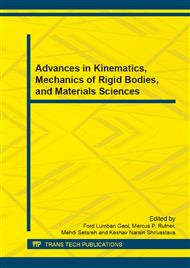p.75
p.83
p.93
p.105
p.111
p.117
p.125
p.131
p.137
Magneto Rheological for Motorcycle Suspension Using Bouc-Wen Model
Abstract:
This paper discusses the application of Magneto-rheological (MR) for motorcycle suspension. Previous studies on the usage of the MR fluids could enhance the performance and improved the vibration in systems such as buildings and vehicles. Therefore, MR motorcycle suspension system is proposed and investigated here by using Bouc-wen model. It is designed to bring comfort and safety to both rider and passenger also to improve the handling ability to the motorcycle. The effectiveness between the MR motorcycle suspension and the passive system is demonstrated by computer simulation. It is found that MR suspension system could eliminate external disturbance which obtain much better ride quality and handling performance to the motorcycle.
Info:
Periodical:
Pages:
111-116
Citation:
Online since:
February 2014
Keywords:
Price:
Сopyright:
© 2014 Trans Tech Publications Ltd. All Rights Reserved
Share:
Citation:


